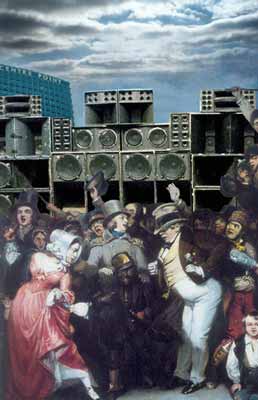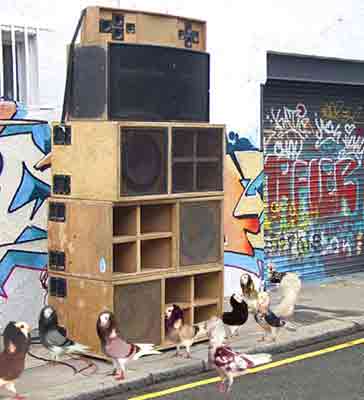
Soundsystem Sound system, amplifiers, speakers, turntables,
record player, acetate record
8 1/2' x 8 1/2' x 38" 2002
Mark Leckey's Soundsystem*:by Donald Goddard |
|
Soundsystem Sound system, amplifiers, speakers, turntables,
record player, acetate record |
The structure stands at the back of a dark room, like a big old Victorian chest. It's taller than the average person and quite wide and bulky. An array of large and small speakers is stacked next to a turntable, amplifiers, and whatever else is required for the contemporary production of sound in a way that looks something like a huge constructivist painting, in a black, red, and plywood grid of circles and squares. The artist was due to paint silhouettes of birds (hawks?) on the front of the structure in the week of April 22 to finish the work. When it begins, the record plays the opening theme of Richard Strauss's Also Sprach Zarathustra, an homage perhaps to Stanley Kubrick, who lived and died in England (after The Bronx and Hollywood), and who used the Strauss theme at the beginning of 2001: A Space Odyssey. Only now the notes are electronic and they serve as a fanfare for life in Soho, London, the scene of A Clockwork Orange, Kubrick's subsequent film, rather than in space. They are notes that have become something of a cliché since the movie, used as bowdlerized, portentous introductions to products and sporting events. Thus is the entire subject matter of life in the streets raised to a level of ceremonial grandeur and significance. And so it should be. |
 Sweepsound, 2002 Dubplate Print from one of the 25 records with sleeves 12 x 12 inches 2002 Edition of 2 All images courtesy Gavin Brown's enterprise, New York. |
Then you hear a man saying "Where are we?" several times and a woman commenting in French on the "junkies," and for the next twelve minutes or so, repetitive and pounding electronic rhythms, mixed with streets sounds of police sirens, people singing and talking, and vehicle traffic moving and bustling, boom out of the various speakers, until the final sustained crescendo of a note that sounds like it was produced by a horn. The structure is an artifact that contains everything in the form of sound, including time, which in fact has limits. In the words of the press release, ". . . one moment becomes another, Victorian ragamuffins steam past McDonalds and as the bass plummets your ribs shake like a vibraphone and our teeth nearly fall out of our heads. Sound loses all sequence, and at 4000 watts, 200 years in Old Compton Street crunches together instantly with bad acid crystal clarity." |

Pigeon Dealers, 2002 Dubplate Print from one of the 25 records with sleeves 1 x 12 inches 2002 Edition of 2 All images courtesy Gavin Brown's enterprise, New York. |
In a second version, the same score, playing through the same structure, becomes the track for a video combining stills and moving images that is shown on the wall of the darkened room, starting with a map of the Soho district and the eye of a hawk, a hawkeye, in its concentric circles the optical equivalent of the soundsystem speaker and the introduction to a tale of surveillance, police and otherwise. What was heard is now seen. The sounds are embodied in a group of black bikers, young people crowding the streets and bars, young people being arrested, action in a strip joint, a man being mugged, and, finally, a man who disappears in brilliant white light--who can no longer be seen, as the horn sounds. To complete the transition from sound to silence, about 30-40 stills are arranged in a single horizontal row in another room. The transformation from assaultive reality to meditation has been completed. |
| Leckey makes the opening of space and time a function of sound. Pictures are not enough. They are floating in ether, in memory, not real. They have no substance, except that of their own flatness. Sound encompasses space and time from all directions, so that the past, particularly in the confines of an historical part of the city, has some bearing on the present. When the images do appear they have another dimension; they actually mean something in terms of their reality, something both within and beyond what the police are looking for. They aren't simply part of a movie that has been scored to intensify or dramatize the action; rather the images and sounds slip from one dimension to the other so that sounds exist visually and images aurally, and it is impossible to escape the totality that is created. The Soundsystem is like a face or a body in the gallery, and in the video and pictures it appears on the street in various incarnations, watching like some Surrealist dream object, absorbing and reiterating what is around it. This massive thing with all its noise is impossible to dismiss, in the mind at least, and it takes the form of an abstract construction, something like the totem in Kubrick's film.
Donald Goddard © 2001 |
Art Review - NYArtWorld.com - NYAW.com. All artwork is copyright of the respective owner or artist. All other material © Copyright 2015 New York Art World ®. All Rights Reserved.
New York Art World ® - Back to Top